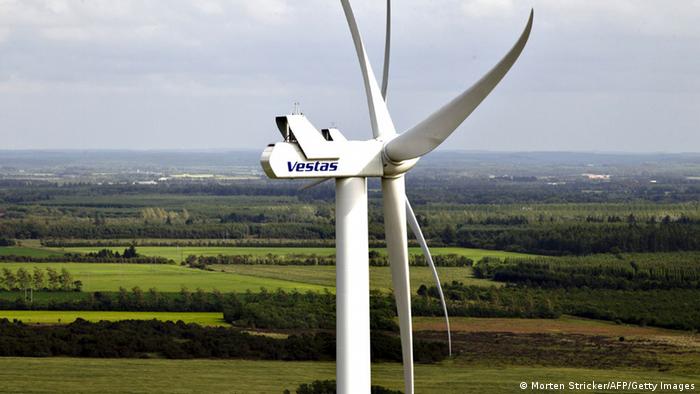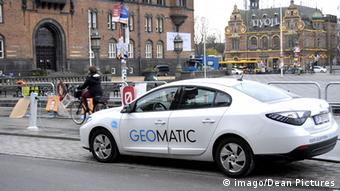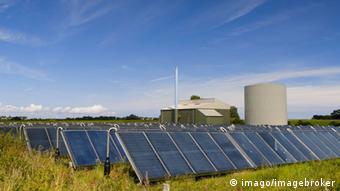Denmark leads the charge in renewable energy | By 2020, the country aims to produce 70 percent of its energy from renewable sources and to make the switch to renewables completely by mid-century. "Today, we're already at 43 percent," said Kristoffer Böttz
But offshore wind farms alone are not enough to meet energy demands, and
so wind power projects have also been expanded on land. Local
resistance to growing wind power plants often prevented further
development in the past, but in 2008 the government introduced new
requirements that brought about greater acceptance.
For example, said Böttzauw, residents are now directly compensated for
any loss. If a house loses its value after one of the 150-meter high
wind turbines pops up nearby, the operator must compensate homeowners
for that loss. In addition, at least 20 percent of the shares in the
project must be offered to local residents, giving them a direct stake
in the investment.
Finally, said Böttzauw, the community receives a direct allocation per
megawatt of power generated. All these measures have greatly increased
acceptance of wind farms in the local community, he said, as they "bring
direct benefits to the community and its citizens if they give their
support."
The Danes have also taken into account objections to increasing power
lines, solving that problem with underground cables. Böttzauw admitted
that it's an expensive solution, but said locals could not be expected
to put up with new utility poles in addition to the towering turbines.
The only exception will be the large offshore wind farms, which will
make use of three new power lines to distribute electricity throughout
the country.
Intelligent storage concepts
Böttzauw admitted that the biggest problem with the abolition of fossil
fuels will be in the transport sector. But, he said, increased
electromobility will help solve the problem. "You can't decide when the
wind blows," he said. "But you can use electric cars to store the power
generated by wind energy." When the grid is running low, car batteries
will be able to send stored energy back into the system.
Denmark is also looking into using heat pumps for storage, so
that when wind farms are generating excess capacity, the extra
electricity can be stored in the form of heat and later be used to heat
homes and businesses.
"When the wind is really blowing, there is no cheaper electricity than
wind energy," said Böttzauw. And when the wind isn't blowing, Denmark
might be able to turn to the sun instead. For that reason,
Energistyrelsen has increasingly invested in solar energy systems. To
meet the rest of Denmark's energy demands, the country makes use of
biomass, supplemented by energy savings and energy efficiency.
The plan seems to be working: According to the country's Department of
Energy, the Danish economy has grown by 78 percent since 1980, even
though energy consumption has remained nearly the same.
Exports and job creation
In Germany, a popular argument against renewable energy is the lack of
competiveness: consumers are obliged to pay a surcharge in the name of
renewable energy, while energy-intensive industries are exempt from the
levies. Greenpeace's Austrup says it's outrageous. "At the moment, the
German industry is the biggest winner of the energy transition. They
haven't seen such low electricity prices for at least 10 years. "
The Danish government has chosen a different path. Companies
receive a subsidy if they use renewable energy and increase their energy
efficiency, a policy that encourages creativity and leads to savings.
In 2010, the Danish energy technology sector accounted for about 10
percent of the country's exports. In order to continue being a market
leader, Denmark has invested heavily in research and the promotion of
renewable energy, energy-efficient technologies and renewable heat
supply systems. Every year, the sector is responsible for creating
around 6,000-8,000 new jobs in the country of 5.5 million people.
Serving as a model
Denmark's success has caught the attention of other countries around the world,
including China.
Böttzauw told DW that the two countries have been cooperating on energy
projects since 2006, starting with wind energy but expanding into the
development of renewable energies in 2010.
"China has expressed a great interest in our district heating systems,
along with biomass technology and offshore wind turbines," said
Böttzauw. He's pleased that China has shown interest - as well as with
the success of Danish energy technology, which includes everything from
pumps to wind turbines, insulation technology to thermostats.
But economic interests were not the focus of the cooperation, said
Böttzouw. "We went to China to help deal with the energy and climate
problems caused by economic growth there" - the same motivation that has
driven Denmark's energy policies. "We just want to show that it's
feasible."



No comments:
Post a Comment